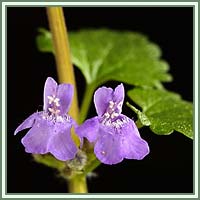GROUND IVY
Glechoma hederacea
Common name: Ground Ivy
Latin name: Glechoma hederacea
Other names: Gill Over the Ground, Creeping Charlie
Family: Laminaceae
Habitat: The plant is native to Europe and southwest Asia. It usually grows in floodplain forests, semi-shaded areas near the rivers, lawns, cemeteries, waste areas.
Description: Ground Ivy is a perennial, evergreen creeping plant. It forms a low-growing mat to stems and leaves over the ground. Leaves are opposite, green to purple-green. Ground Ivy flowers from mid-spring to early summer. Flowers are formed in clusters, tubular and violet blue. Upon maturity, each flower is replaced by four ovoid, brown nutlets.
Parts used: Flowering plant, leaves.
Medicinal use: Ground Ivy is considered to be astringent, pectoral, tonic and stimulant. Tea from fresh herb is rich in vitamin C. Along with its volatile oils, it is useful in treatments of headaches, inflamed mucous membranes (ear, nose, throat), fly symptoms, colds and sinusitis. Ground Ivy is used as a spring tonic and an appetite stimulant. Externally, ground Ivy promotes healing of bruises and black eyes. Ground Ivy juice is considered to be a calming eye wash.
Safety: When taken in large amounts, Ground Ivy can be toxic. Some herbs could interact with certain medication. Always consult your doctor before consumption of any herb.

